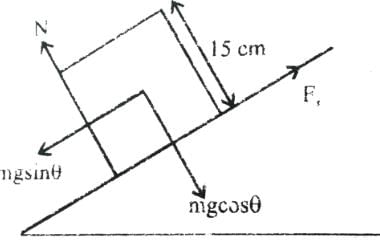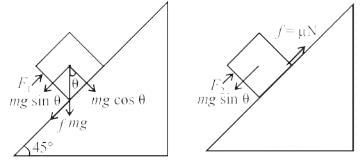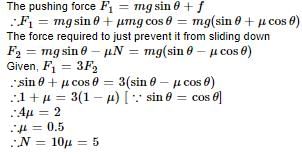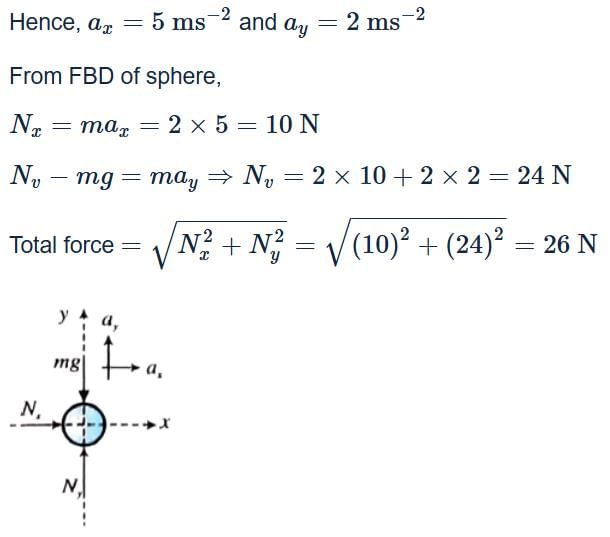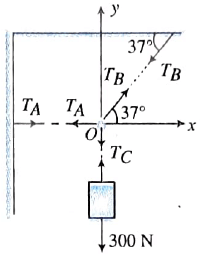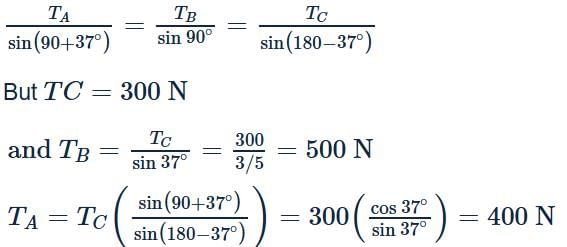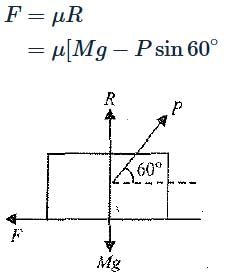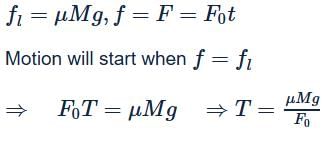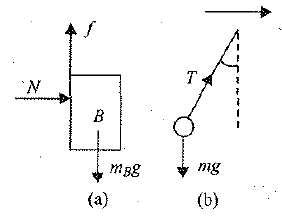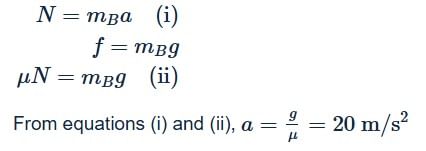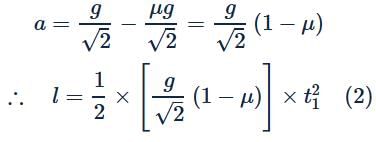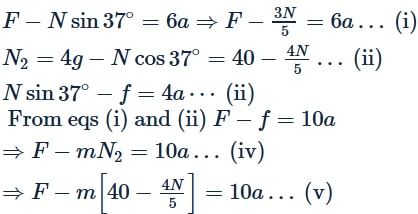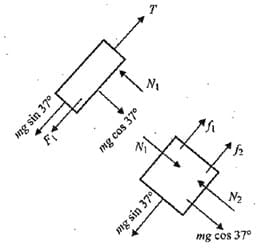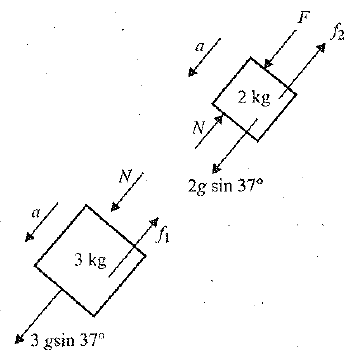Test: Laws of Motion I - JEE MCQ
30 Questions MCQ Test - Test: Laws of Motion I
A car of mass 1000 kg is moving at a velocity of 20 m/s. Suddenly, the driver applies the brakes, and the car comes to a stop in 4 seconds. What is the magnitude of the average force exerted by the brakes on the car? (Assume no external forces are acting on the car)
A constant force acting on a body of mass 3 kg changes its speed from 2 m/s to 3.5 m/s in 10 second. If the direction of motion of the body remains unchanged, what is the magnitude and direction of the force?
A simple pendulum is oscillating in a vertical plane. If resultant acceleration of bob of mass m at a point A is in horizontal direction, find the tangential force at this point in terms of tension T and mg.
A painter is applying force himself to raise him and the box with an cceleration of 5 m/s2 by a massless rope and pulley arrangement as shown in figure. Mass of painter is 100 kg and that of box is 50 kg. If g = 10 m/s2, then :
Two blocks ‘A’ and ‘B’ each of mass ‘m’ are placed on a smooth horizontal surface. Two horizontal force F and 2F are applied on the two blocks ‘A’ and ‘B’ respectively as shown in figure. The block A does not slide on block B. Then the normal reaction acting between the two blocks is :

A block of base 10 cm × 10 cm and height 15 cm is kept on an inclined plane. The coefficient of friction between them is . The inclination q of this inclined plane from the horizontal plane is gradually increased from 0º. Then [jee 2009]
A block is moving on an inclined plane making an angle 45º with horizontal and the coefficient of friciton is μ. the force required to just push it up the inclined plane is 3 times the force requried to just prevent it from sliding down. If we define N = 10μ, then N is
[jee 2011]
The dimensional formula of Plancks’s constant and angular momentum are
Three forces  act on an object of mass m = 2 kg. The acceleration of the object in m/s2 is:
act on an object of mass m = 2 kg. The acceleration of the object in m/s2 is:
A ball weighing 0.01kg hits a hard surface vertically with a speed of 5m/s and rebounds with the same speed. The ball remains in contact with the surface for 0.01s. The average force exerted by the surface on the ball is
A machine gun has a mass of 20 kg fires 35 g bullets at the rate of 400 bullets per second with a speed of 400ms-1 .What force must be applied to the gun to keep in the position?
A block of mass 2 kg is initially at rest on a frictionless horizontal surface. A force of 8 N is applied to the block horizontally for 5 seconds. What is the final velocity of the block?
Two masses are in the ratio 1:5. What is ratio of their inertia?
A 6 kg object is subject to three forces
F1 = 20i + 30j N
F2 = 8i - 50j N
F3 = 2i + 2j N
Find the acceleration of object.
An object of mass 5 kg is initially moving with a velocity of 10 m/s. An unbalanced force of 30 N is applied to the object in the opposite direction of its motion. Calculate the acceleration of the object.
A particle of mass 'm' original at rest, is subjected to a force whose direction is constant but whose magnitude varies with according to the relation

Where F0 and T are constant.
Then speed of the particle after a time 2T is:
A toy cart has mass of 4 kg and is kept on a smooth horizontal Surface. Four blocks A,B,C and D of masses 2 kg,2 kg, 1 kg and 1 kg, respectively, have been placed on the cart. A horizontal force of F=60 N is applied to the block A (see figure). Find the contact force between block D and the front vertical wall of the cart.

A solid sphere of mass 2 kg is resting inside a cube as shown in figure The cube is moving with a velocity  . Here t is time in seconds. All surfaces are smooth. The sphere is at rest with respect to the cube. What is the total force exerted by the sphere on the cube?
. Here t is time in seconds. All surfaces are smooth. The sphere is at rest with respect to the cube. What is the total force exerted by the sphere on the cube?
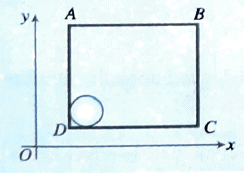
In the Fig., the ball A is released from rest, when the spring is at its natural (unstretched) length. For the block B of mass M to leave contact with ground at some stage. the minimum mass of A must be
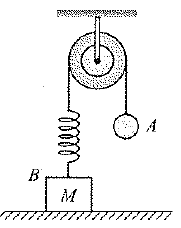
Three forces are acting on a particle of mass m initially in equilibrium. If the first 2 forces (R1 and R2) are perpendicular to each other and suddenly the third force (R3) is removed, then the acceleration of the particle is
A block of mass 30 kg is suspended by three strings as shown in figure. Find the tension in each string.
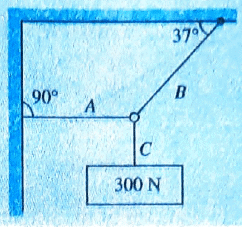
A block of mass 1 kg is at rest on a horizontal table. The coefficient of static friction between the block and the table is 0.50. If g=10 ms−2, then the magnitude of a force acting upwads at an angle of 60∘ from the horizontal that will just start the block moving is:
A body of mass M is resting on a rough horizontal plane surface, the coefficient of friction being equal to μ. At t = 0 a horizontal force F = F0t starts acting on it, where F0 is a constant. Find the time T at which the motion Starts?
A trolley A has a simple pendulum suspended from a frame fixed to its desk. A block B is in contact on its vertical slide. The trolley is on horizontal rails and accelerates towards the right such that the block is just prevented from falling. The value of coefficient of friction between A and B is 0.5 (see Fig.). The inclination of the pendulum to the vertical is
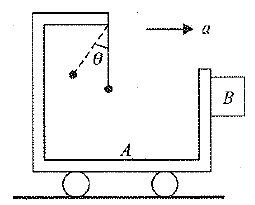
Starting from rest, a body slides down a 45∘ inclined plane in twice the time it takes to slide the same distance in the absence of friction. What is the coefficient of friction between the body and the inclined plane?
Two blocks A of 6 kg and B of 4 kg are placed in contact with each other as shown in Fig. There is no friction between A and ground and between both the blocks. Coefficient of friction between B and ground is 0.5.A horizontal force F is applied on A. Find the minimum and maximum value of F which can be applied so that both blocks can move combinely without any relative motion between them.
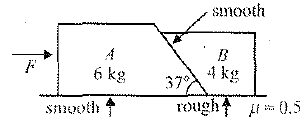
Two blocks A and B each of mass m are placed one over another on an incline as shown in Fig. When the system is released from rest the block A slides down with constant velocity while block B rests on top of A. If the coefficient of friction between A and B and between A and incline are same, then value of coefficient of friction would be
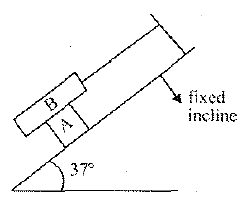
The system shown in Fig. is released from rest. The spring gets elongated
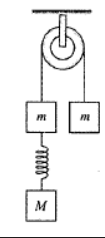
Two blocks of masses 3 kg and 2 kg are placed side by side on an incline as shown in the Fig. A force, F=20 N is acting on 2 kg block along the incline. The coefficient of friction between the block and the incline is same and equal to 0.1, find the normal contact force exerted by 2 kg block on 3 kg block. .







